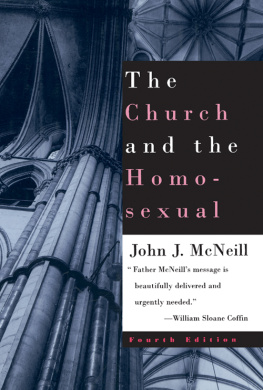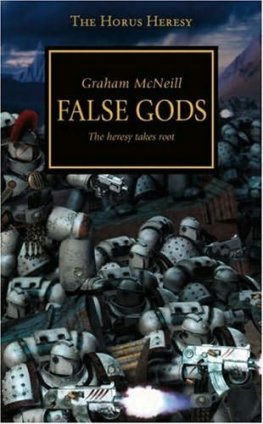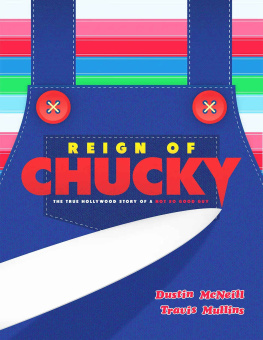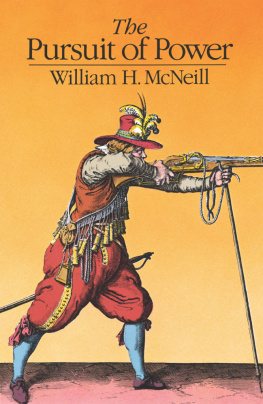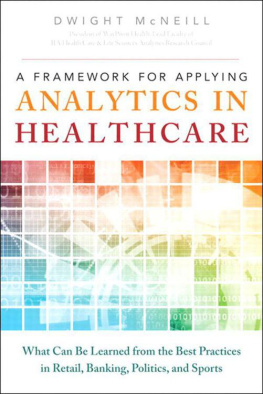John J. McNeill - The Church and the Homosexual
Here you can read online John J. McNeill - The Church and the Homosexual full text of the book (entire story) in english for free. Download pdf and epub, get meaning, cover and reviews about this ebook. year: 1993, publisher: Beacon Press, genre: Religion. Description of the work, (preface) as well as reviews are available. Best literature library LitArk.com created for fans of good reading and offers a wide selection of genres:
Romance novel
Science fiction
Adventure
Detective
Science
History
Home and family
Prose
Art
Politics
Computer
Non-fiction
Religion
Business
Children
Humor
Choose a favorite category and find really read worthwhile books. Enjoy immersion in the world of imagination, feel the emotions of the characters or learn something new for yourself, make an fascinating discovery.
- Book:The Church and the Homosexual
- Author:
- Publisher:Beacon Press
- Genre:
- Year:1993
- Rating:4 / 5
- Favourites:Add to favourites
- Your mark:
- 80
- 1
- 2
- 3
- 4
- 5
The Church and the Homosexual: summary, description and annotation
We offer to read an annotation, description, summary or preface (depends on what the author of the book "The Church and the Homosexual" wrote himself). If you haven't found the necessary information about the book — write in the comments, we will try to find it.
The Church and the Homosexual — read online for free the complete book (whole text) full work
Below is the text of the book, divided by pages. System saving the place of the last page read, allows you to conveniently read the book "The Church and the Homosexual" online for free, without having to search again every time where you left off. Put a bookmark, and you can go to the page where you finished reading at any time.
Font size:
Interval:
Bookmark:


I pray that
with Gods merciful grace
this book may serve the spiritual good
of my lesbian sisters and
gay brothers and
all who read it.
I still remember our joy that Sunday in 1976 when I announced at the New York Dignity liturgy that I had received an official Imprimi Potest, the approval for the publication of my book The Church and the Homosexual from my superiors in the Society of Jesus. It was, I believe, one of the first theological works in recent times that called for a revision of the traditional Catholic Church teaching on homosexuality.
After more than four years of exhaustive research to write the book, the Imprimi Potest was obtained only after an additional two years of intense review by leading moral theologians both in the United States and in Rome. They were unanimous in recommending that the book be published. I naively assumed that by granting me an Imprimi Potest, the Church, in the liberating spirit that followed Vatican II, was ready and willing to reexamine its teaching on homosexuality and that approving my book for publication was the first step in that process. The theologians who reviewed the manuscript believed, as I did, that the new evidence coming from the fields of scriptural studies, history, psychology, sociology, and moral theology seriously challenged every premise on which the traditional teaching was based. They anticipated, as I did, that my book would begin a public debate on Church teaching that would eventually lead to the Churchs revision of its understanding of homosexuality. I had hoped that my book would lead to a revision of teaching on homosexuality not only in the Roman Catholic Church but also in the entire Christian community.
From the beginning, I envisioned the personal witness of gay and lesbian Catholics and other Christians to be an essential contribution to that debate. They could testify about what happened to them when they strove to live both as gays and according to Church teachings. My own work in the gay community as priest and psychotherapist and as one of the founders of Dignity/New York, an organization for gay and lesbian Catholics, made me keenly aware of the enormous amount of pain, psychological trauma, and potential emotional breakdown there. Because this unnecessary suffering was caused by the interiorization of Church teaching, I felt a certain urgency for the need of public debate. What was bad psychology had to be bad theology and vice versa.
Our early joy was short-lived, however. One year later, in 1977, the Congregation for the Doctrine of the Faith (CDF) ordered the removal of the Imprimi Potest from my book. Because of my appearances on popular television programs such as Today and The Phil Donahue Show, they accused me of violating a nonexistent agreement that the public discussion would take place only among my peers in the theological community. A blanket silence was imposed on me by the CDF and I was forbidden to discuss the issue of homosexuality and morality in the public arena. Instead of allowing public debate on homosexuality, the Church fell back on its creeping infallibility, claiming that its teaching was based on divine revelation and, therefore, was not open to change, regardless of any new evidence to support that change. (In fact, no moral teaching on sexuality is infallibly defined.) They justified their silencing me by claiming that I had created the false impression that the Church had changed or was about to change its teaching on homosexuality. The CDF hastened to assure the world that no matter how much evidence supported the argument for change, the Church would never alter its teaching in this matter. This is true because we say it is true. Dont bother us with the facts!
From that day to this, for nearly seventeen years, the hierarchical Church has used its power and influence to silence any critic of its teaching on homosexuality. The dismissal of Charles Curran from the theology faculty at the Catholic University of America is another example. The debate has continued, however, among the laity. There has been such a massive shift of opinion in the pews that now more than 84 percent of Catholics support gay civil rights.
For ten years, until 1987, I observed the silence imposed on me by not speaking in public. During that period, my book was published around the world in five different languages. I had agreed to observe the silence, again in the hope that over time the Church would consider the evidence and begin a process of reevaluation. The American bishops did take several progressive steps toward liberalizing pastoral practice based on the distinction between homosexual orientation, which is neither chosen nor changeable, and homosexual behavior, which they continued to judge as contrary to Gods will. They also called for legislation protecting the civil rights of gay people. But every time any move was made toward a better understanding and spiritual care of gay people, the Vatican intervened demanding that the Catholic Church in the United States maintain a homophobic stance on all gay issues. The best example of that interference is the Vatican demand in 1987 that all Dignity chapters be denied their right to meet on Church grounds.
One major event in the struggle between gay Catholics and the Vatican was the release of the Vatican Halloween letter by Cardinal Ratzinger, head of the Congregation for the Doctrine of the Faith, on 31 October 1986: Letter to the Bishops of the Catholic Church on the Pastoral Care of Homosexual Persons. Rome took a giant step backward when it asserted that homosexual orientation was not a natural condition but represented an objective disorder and was an orientation to evil. Since most gay people experience their homosexual orientation as a part of creation, if they accept this Church teaching, they must see God as sadistically creating them with an intrinsic orientation to evil. Most gays would prefer to see the Church teaching as wrong, rather than believe God is sadistic.
The Vatican document went so far in its hatred of all things gay as to assert that if homosexuals continue to claim unthinkable civil rights, then they should not be surprised by the violence inflicted upon them by gay-bashers and have only themselves to blame. This statement has been interpreted in some quarters as encouraging violence against gay people. Cardinal Ratzingers letter even suggested that it is gay activists and the professionals who try to help gays achieve self-acceptance who are responsible for the AIDS epidemic: Even when the practice of homosexuality may seriously threaten the lives and well-being of a large number of people, its advocates remained undeterred and refused to consider the magnitude of the risks involved.
In my more than twenty years experience of pastoral care with thousands of gay Catholics and other Christians, the gay men most likely to act out their sexual needs in an unsafe, compulsive way and, therefore, to expose themselves to the HIV virus, are precisely those persons who have internalized the self-hatred that their religions impose on them. They are precisely the ones who, while they find it impossible to suppress and deny their sexual needs totally, cannot enter into a healthy and committed intimacy with anyone because of this self-hatred.
In a recent letter to the New York Times (2 September 1992), Richard Isay, chairman of the American Psychiatric Association committee on gay, lesbian, and bisexual affairs, points out that the suppression of sexuality, whether by religion, the state, or therapists who claim they can change homosexuals into heterosexuals, significantly damages the self-esteem of gay men and lesbians. It subverts their capacity to express their sexuality in mutually loving relationships. Interiorized self-hatred contributes to the extraordinarily high suicide rate of gay and lesbian youth, estimated at more than 30 percent of all youth suicide.
Font size:
Interval:
Bookmark:
Similar books «The Church and the Homosexual»
Look at similar books to The Church and the Homosexual. We have selected literature similar in name and meaning in the hope of providing readers with more options to find new, interesting, not yet read works.
Discussion, reviews of the book The Church and the Homosexual and just readers' own opinions. Leave your comments, write what you think about the work, its meaning or the main characters. Specify what exactly you liked and what you didn't like, and why you think so.

